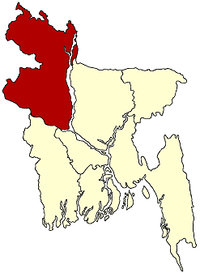

Varendra (Bengali: বরেন্দ্র), also known as Barind (Bengali: বারিন্দ), was an ancient and historical territory of Northern Bengal, now mostly in Bangladesh and a little portion in the Indian state of West Bengal.[1][2]
It formed part of the Pundravardhana or Pundra Kingdom region currently part of Rangpur and Rajshahi Divisions of Bangladesh and included the districts of Bogra, Rajshahi, Pabna and Dinajpur of Bangladesh and West Dinajpur of India. According to Cunningham, the boundary of Varendra was the Ganges and the Mahananda on the west, the Karatoya on the east, the Padma River on the south and the land between Cooch Behar and the Terai on the north.[2]
Literature and inscriptions[edit]
According to R. C. Majumdar, the term Varendra-mandala occurs in the Ramacharitam, which places it between the Ganges and Karatoya rivers. He writes, "Its inclusion with Pundravardhana is proved by the Silimpur, Tarpandighi and Madhainagar inscriptions. The Tabaquat-i-nasiri mentions Barind as the wing of the territory of Lakhnawati on the eastern side of Ganges".[1]
History[edit]
Historical evidence attests significant presence of Brahmins in Bengal during the Maurya period. The Jain Acharya Bhadrabahu, regarded to be the preceptor of Chandragupta Maurya, is said to have been born in Brahmin family of Pundravardhana (or Puṇḍra, the region north of the Ganges and west of Brahmaputra in Bengal, later known as Vārendra).[2] Such evidences suggest Puṇḍra or Vārendra and regions west of Bhagirathi (called Radha in ancient age) to be seats of Brahmins from ancient times;
According to HC Raychoudhuri the Gupta dyansty originated from the Varendri region.[3] According to the Khalimpur copper plate inscription, the first Pala Emperor Gopala was the son of a warrior named Vapyata. The Ramacharitam attests that Varendra (North Bengal) was the fatherland (Janakabhu) of the Palas.
Ancient empires and rulers originated from Varendra region[edit]
- Mauryan Empire[citation needed]
- Gupta Empire[3]
- Pala Empire[4]
- Kingdom of Raja Ganesha
- Kalapahad
- Baro-Bhuyan (Bhati Rulers)
- Diwan Mohanlal[citation needed]
Modern day prime ministers, president and chief ministers originated from Varendra region[edit]
Notable Varendra Brahmins[edit]
- Raja Ganesha, a Hindu ruler of Bengal
- Rani Bhabani, a Hindu zamindar of Natore
- Gautam Sanyal, Indian civil servant
- Surajit Chandra Lahiri, former Chief Justice of Calcutta High Court
- Nalinaksha Sanyal, Indian politician, economist and freedom fighter.
- Narayan Sanyal, writer of modern Bengali literature as well as a civil engineer.
- Pahari Sanyal, Indian actor and singer
- Sachindra Nath Sanyal, an Indian revolutionary and a founder of the Hindustan Republican Association
- Sanjeev Sanyal, Indian economist and author.
- Jaya Bachchan (originally Bhaduri), Indian film actress, politician and a member of Parliament
- Amar Nath Bhaduri, Indian molecular enzymologist and chemical biologist
- Abhijit Bhaduri, Indian author, columnist and management consultant
- Nrisingha Prasad Bhaduri, Indian historian, writer and Indologist
- Sisir Bhaduri, Indian stage actor and theatre founder
- Shibdas Bhaduri, Indian professional footballer
- Anirban Lahiri, Indian professional golfer
- Bappi Lahiri, an Indian singer, composer.
- Jhumpa Lahiri, American author
- Mahua Moitra, Indian politician and a Member of parliament
- Shantanu Moitra, Indian score composer, musician and pianist
- Rupankar Bagchi, Bengali singer-songwriter and playback singer.
- Jatindramohan Bagchi, Bengali poet and editor.
- Subroto Bagchi, Indian entrepreneur and business leader
- Tanishk Bagchi, Indian music producer, composer and singer.
- Biman Bagchi, Indian National Science Chair Professor
Modern usage[edit]
- Varendra Research Society
- Varendra Research Museum
- Varendra rebellion
- Varendra University
- Varendra tract
See also[edit]
References[edit]
- ^ a b Majumdar, R. C. (1971). History of Ancient Bengal. Calcutta: G. Bhardwaj & Co. p. 13. OCLC 961157849.
- ^ a b c AM Chowdhury (2012). "Varendra". In Sirajul Islam; Miah, Sajahan; Khanam, Mahfuza; Ahmed, Sabbir (eds.). Banglapedia: the National Encyclopedia of Bangladesh (Online ed.). Dhaka, Bangladesh: Banglapedia Trust, Asiatic Society of Bangladesh. ISBN 984-32-0576-6. OCLC 52727562. OL 30677644M. Retrieved 23 March 2024.
- ^ a b https://en.banglapedia.org/index.php/Gupta_Rule#:~:text=In%20the%20Gupta%20period%2C%20Bengal,the%20largest%20unit%20of%20administration.
- ^ Insight, Apa Productions (November 1988). South Asia. APA Publications. p. 317